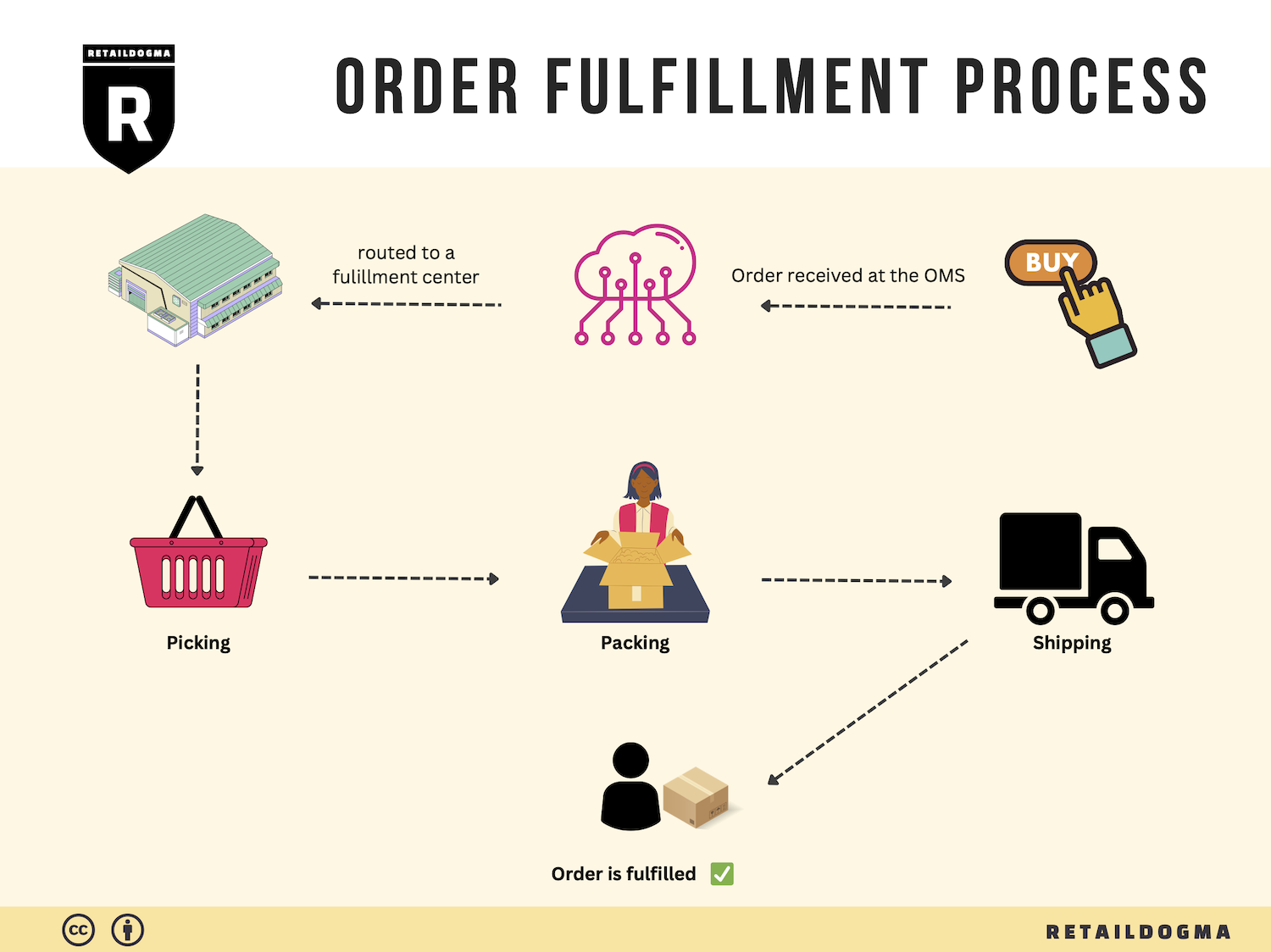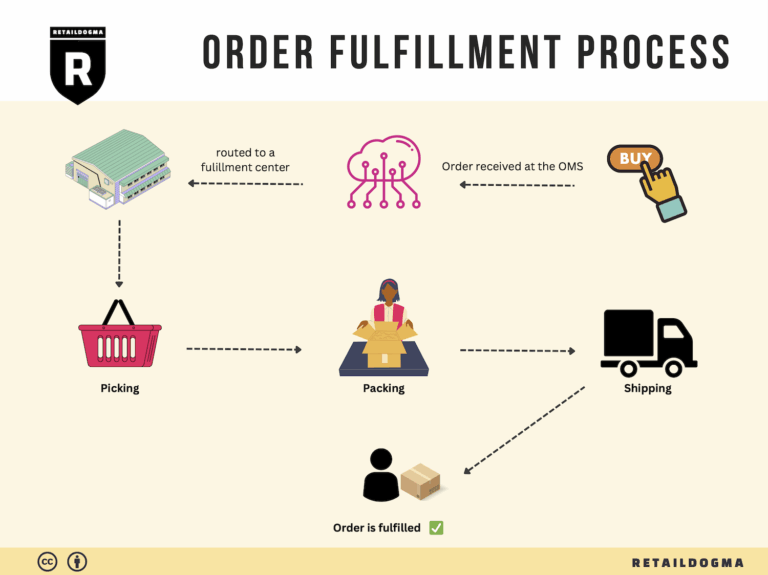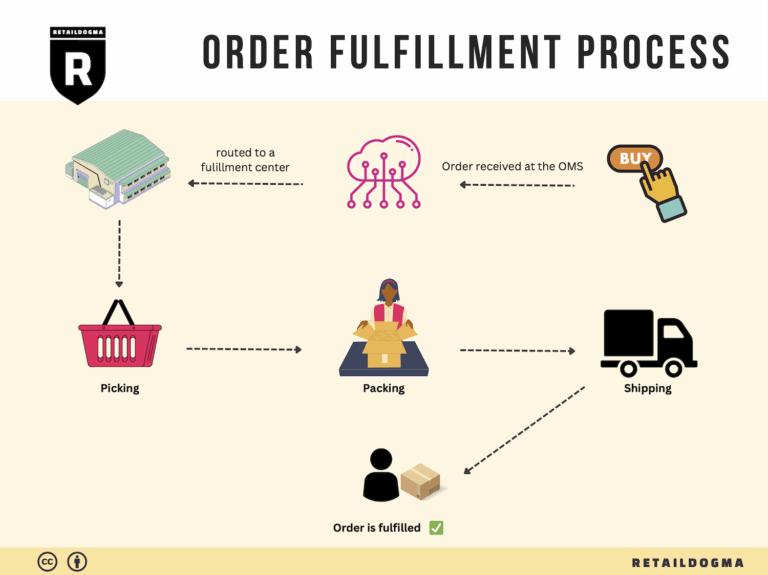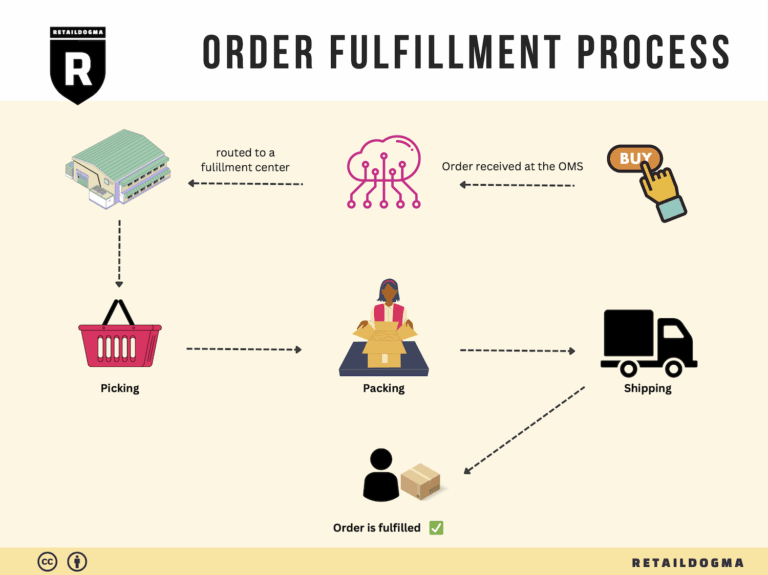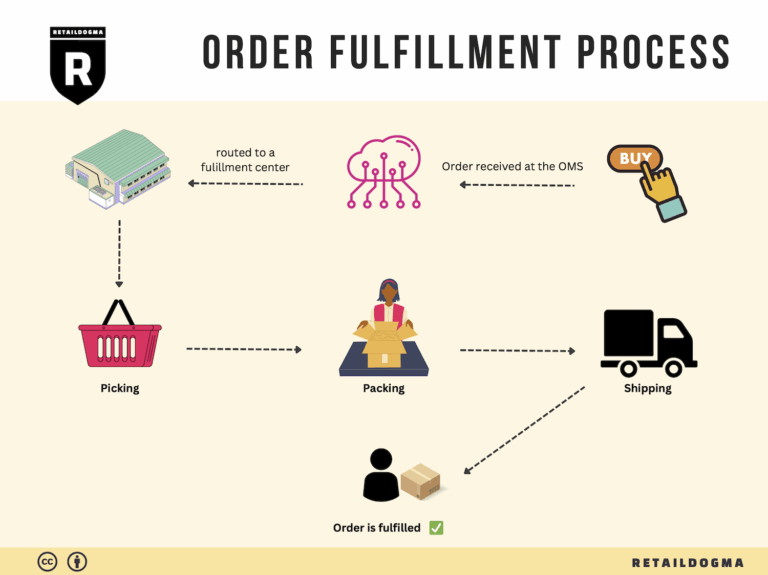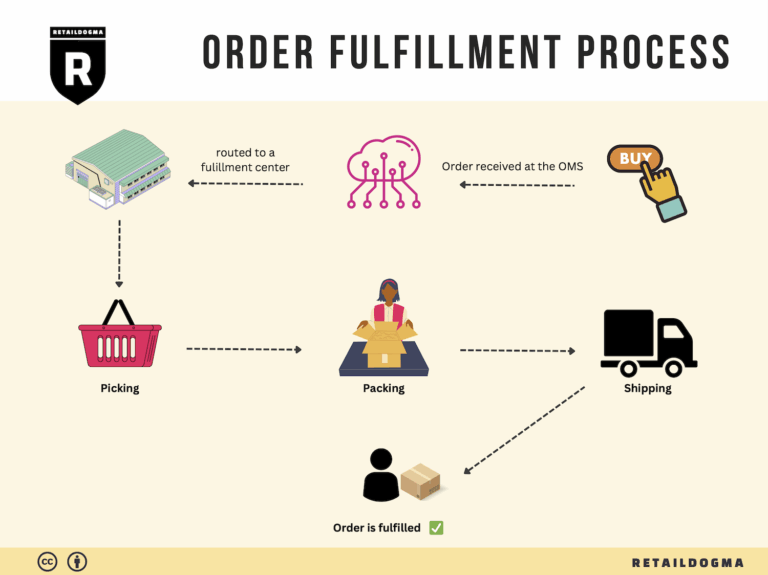Ecommerce Fulfillment Services: The Ultimate Guide (2025)
What is E-commerce Fulfillment? An Introduction for Growing Businesses
Understanding E-commerce Fulfillment: A Guide for Growing Businesses
As your e-commerce business begins to thrive, the excitement of increased sales can quickly turn into the stress of managing logistics. One of the most common pain points for growing online businesses is feeling overwhelmed with the packing and shipping of orders. From sourcing products to ensuring timely deliveries, the fulfillment process can become a daunting task, often consuming valuable time and resources that could be better spent on scaling your operations and improving customer satisfaction.
At its core, e-commerce fulfillment is the process of getting a product from your inventory to your customer’s doorstep. This involves various steps, including receiving inventory, processing orders, packing items, and shipping them out. For many businesses, especially those just starting, understanding the intricacies of fulfillment can be challenging. However, it is essential to streamline this process to enhance efficiency and provide an excellent customer experience.
In this guide, we will explore the different fulfillment models available to e-commerce businesses, including Third-Party Logistics (3PL) and Fulfillment by Amazon (FBA). Each model has its own set of advantages and challenges, and understanding these can help you choose the right approach for your business needs.
We’ll also delve into the core services offered by fulfillment centers, such as inventory management, order processing, and shipping options. Knowing what services are available can help you determine which fulfillment partner aligns best with your operational goals.
Choosing the right fulfillment partner is a critical decision that can significantly impact your business’s success. We will provide practical tips on evaluating potential partners based on their capabilities, reliability, and technological integration.
Additionally, pricing strategies for fulfillment services can vary widely. We will break down the factors that influence costs and provide insights into how to manage and optimize your fulfillment budget.
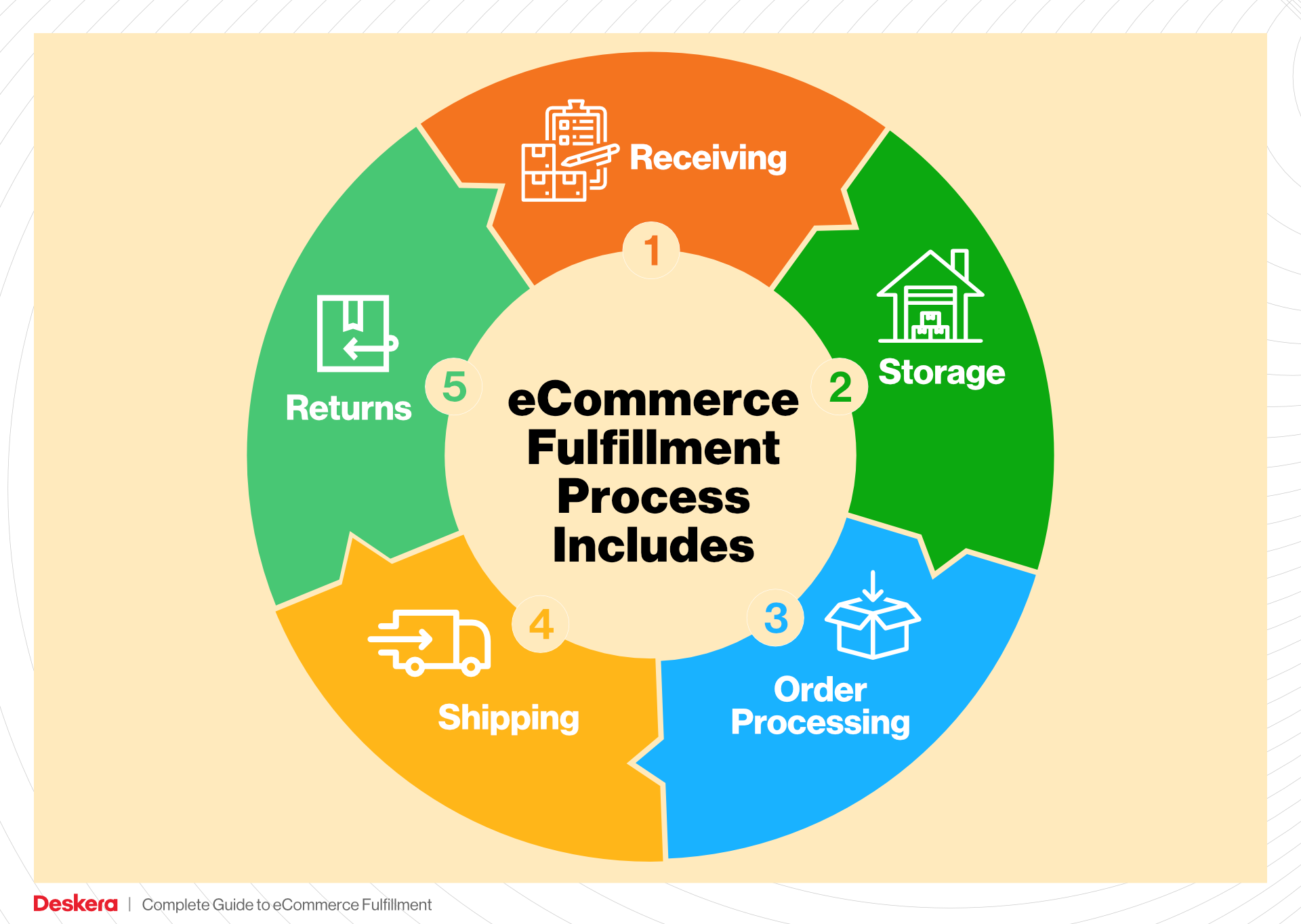
Ultimately, this guide aims to empower you to make informed decisions about your logistics. By understanding the fundamentals of e-commerce fulfillment, you can implement a system that not only meets your current needs but also scales as your business continues to grow. Whether you’re just starting or looking to refine your existing processes, a solid fulfillment strategy is key to achieving long-term success in the e-commerce landscape.
What You’ll Learn In This Guide
- What is E-commerce Fulfillment? An Introduction for Growing Businesses
- The Order Fulfillment Process: From ‘Buy’ Button to Customer’s Door
- Comparing Fulfillment Models: In-House vs. 3PL vs. Dropshipping
- A Deep Dive into Amazon FBA: Pros, Cons, and Who It’s For
- Core Services Offered by Fulfillment Centers
- How to Choose a Fulfillment Partner: A 6-Point Checklist
- Understanding Fulfillment Pricing: A Breakdown of Common Fees
- Frequently Asked Questions (FAQs) about Fulfillment
- Conclusion: Is Outsourcing Fulfillment the Right Move for Your Business?
- Important Disclaimer
The Order Fulfillment Process: From ‘Buy’ Button to Customer’s Door
1. Receiving Inventory
The first step in the order fulfillment process is receiving inventory. This occurs when goods arrive at the fulfillment center, typically via large freight trucks. During this stage, products are unloaded and checked against a purchase order to ensure accuracy. Each item is assigned a Stock Keeping Unit (SKU), a unique identifier that simplifies tracking and managing inventory.
This step is crucial because accurate receiving helps prevent stock discrepancies, which can lead to order fulfillment errors. Efficient receiving practices also set the tone for the entire fulfillment process, ensuring that the right products are available for picking when customer orders come in. Implementing technologies such as barcode scanners can expedite this process and improve accuracy, thus enhancing overall operational efficiency.
2. Warehouse Storage
Once inventory is received, it is organized and stored within the warehouse. This step is known as warehouse storage. Items are placed in designated storage areas based on their SKU, size, and demand. Optimized storage methods, such as bin shelving and pallet racking, are employed to maximize space and facilitate easy access.
Proper warehouse storage is essential for maintaining an organized inventory, which directly impacts the speed and accuracy of order picking. Efficient storage systems reduce the time employees spend searching for products, thereby speeding up the entire fulfillment process. Moreover, using inventory management software can provide real-time visibility into stock levels, helping businesses make informed decisions about reordering and inventory turnover.
3. Order Picking
The next step is order picking, where items are retrieved from their storage locations in response to customer orders. Employees or automated systems generate pick lists that outline the items and quantities needed for each order. This step can be executed using various picking methods, including single-order picking, batch picking, or zone picking, depending on the fulfillment center’s size and order volume.
Effective order picking is vital for ensuring that customers receive the correct items in a timely manner. Mistakes in this phase can lead to customer dissatisfaction and increased return rates. Implementing technology, such as pick-to-light systems or voice picking, can streamline this process, reduce errors, and enhance productivity. Efficient picking not only improves order accuracy but also contributes to faster shipping times, which is increasingly important in today’s competitive e-commerce landscape.
4. Order Packing
After items are picked, the next stage is order packing. This involves carefully placing the picked items into appropriate packaging, which may include boxes, padded envelopes, or poly bags. Each package is labeled with shipping information and often includes an invoice or packing slip. The packing process also involves weighing and measuring the package to ensure it meets the shipping carrier’s requirements.
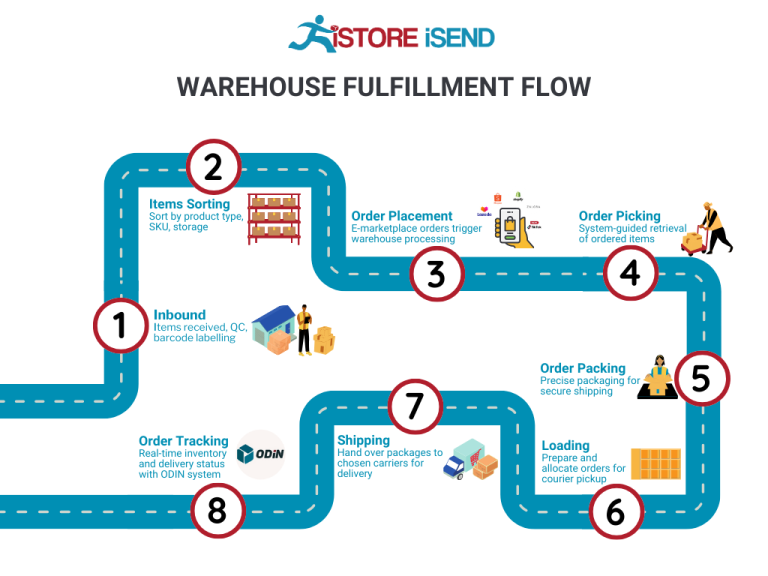
Packing is a critical step because it protects products during transit and ensures compliance with shipping regulations. Additionally, well-packed orders can enhance the customer experience, as they convey professionalism and care. Businesses can utilize packing software that integrates with their inventory management systems to automate label printing and packing slips, further enhancing efficiency and reducing manual errors.
5. Shipping & Delivery
The final step in the order fulfillment process is shipping and delivery. Once packages are packed, they are sorted based on their final destination and loaded onto delivery trucks for dispatch. Depending on the fulfillment strategy, orders may be sent directly to customers or routed through middle-mile sortation centers for further consolidation.
Shipping and delivery are paramount to customer satisfaction, as they directly influence delivery times and reliability. Businesses must choose shipping carriers wisely, considering factors such as cost, speed, and service quality. Offering multiple shipping options, including same-day or next-day delivery, can also enhance customer satisfaction and loyalty. Tracking systems that provide real-time updates on shipment status can further improve the customer experience by keeping them informed throughout the delivery process.
In conclusion, mastering each step of the order fulfillment process—from receiving inventory to shipping and delivery—is essential for e-commerce businesses looking to scale their operations. By optimizing these steps, businesses can improve efficiency, reduce errors, and enhance overall customer satisfaction, setting themselves up for sustainable growth in a competitive marketplace.
Comparing Fulfillment Models: In-House vs. 3PL vs. Dropshipping
Comparison of Fulfillment Models
| Model | Who Handles Inventory | Best For (Business Stage) | Key Advantage | Key Disadvantage |
|---|---|---|---|---|
| In-House Fulfillment | Business itself | Startups to established | Greater control over inventory | High operational costs |
| Third-Party Logistics (3PL) | Third-party logistics provider | Growing businesses | Scalability and expertise | Less control over operations |
| Dropshipping | Supplier | New or small businesses | Low upfront costs | Lower profit margins and longer shipping times |
In-House Fulfillment
In-house fulfillment is when a business manages its own inventory, warehousing, and shipping processes. This model is often favored by startups and established businesses that want to maintain a high degree of control over their logistics and customer experience. The primary advantage of in-house fulfillment lies in the ability to oversee every aspect of the supply chain. Businesses can tailor their operations to meet specific customer needs, optimize packaging, and ensure quality control. However, managing fulfillment in-house can come with significant operational costs, including staffing, warehousing, and technology investments. As businesses scale, these costs can escalate, necessitating a careful analysis to determine whether this model remains viable or if a transition to a more scalable solution, like 3PL, is warranted.
Third-Party Logistics (3PL)
Third-party logistics (3PL) is a fulfillment model where a business outsources its logistics operations to a specialized provider. This model is particularly beneficial for growing businesses that require flexibility and scalability. 3PL providers offer expertise in logistics, access to advanced technology, and established shipping networks, which can help streamline operations and reduce delivery times. By leveraging a 3PL, businesses can focus on their core competencies, such as marketing and product development, while leaving logistics management to experts. However, the downside is that businesses may have less control over their inventory and fulfillment processes. Additionally, relying on a third party means that any disruptions or inefficiencies in the 3PL’s operations can directly impact the business’s performance and customer satisfaction.
Dropshipping
Dropshipping is a fulfillment model where businesses sell products without holding any inventory. Instead, when a customer places an order, the business purchases the item from a third-party supplier who then ships it directly to the customer. This model is particularly appealing for new or small businesses due to its low upfront costs and minimal risk. Entrepreneurs can test markets and experiment with product offerings without the need for large investments in inventory. However, dropshipping also has notable disadvantages. Profit margins can be lower since businesses often pay a premium for the convenience of not holding inventory. Additionally, shipping times may be longer, and quality control can be challenging, as businesses are reliant on suppliers to manage inventory and shipping. As a result, customer satisfaction can suffer if the supplier does not meet expectations.
Conclusion
Choosing the right fulfillment model is crucial for e-commerce businesses seeking to scale effectively. Each model—In-house fulfillment, 3PL, and dropshipping—has its unique advantages and disadvantages. In-house fulfillment offers control but at a higher operational cost, while 3PL provides scalability and expertise at the expense of some operational oversight. Dropshipping minimizes risk and investment but can lead to lower profit margins and potential customer dissatisfaction. Entrepreneurs and operations managers must carefully evaluate their business stage, resources, and long-term goals to select the most appropriate fulfillment strategy that aligns with their growth ambitions.
A Deep Dive into Amazon FBA: Pros, Cons, and Who It’s For
Understanding Fulfillment by Amazon (FBA)
Fulfillment by Amazon (FBA) is a service offered by Amazon that allows e-commerce sellers to store their products in Amazon’s fulfillment centers. Amazon then takes care of storage, packaging, shipping, and customer service for these products. This service enables sellers to leverage Amazon’s vast logistics network and customer base, streamlining their operations while enhancing their reach.
How FBA Works
-
Inventory Management: Sellers send their products to Amazon’s fulfillment centers. Amazon has numerous fulfillment centers across the globe, including the Amazon MCO1 center in Orlando, Florida, which is a state-of-the-art facility designed to optimize storage and shipping efficiency.
-
Storage: Once products arrive at the fulfillment center, they are stored until sold. Amazon uses a sophisticated inventory management system to track products and ensure they are accessible for quick processing.
-
Order Processing: When a customer places an order for a product, Amazon picks, packs, and ships the item on behalf of the seller. The average processing time is impressively quick, with many orders dispatched within hours.
-
Customer Service: Amazon also manages customer service and returns for FBA products. This means sellers do not need to handle inquiries or complaints directly, allowing them to focus on other areas of their business.
-
Prime Eligibility: Products fulfilled by Amazon are eligible for Amazon Prime, which offers free two-day shipping to Prime members. This feature significantly enhances the appeal of products for potential buyers, as Prime members often prefer items that qualify for fast shipping.
Pros of Using FBA
1. Prime Eligibility
Being part of the Amazon Prime program is a significant advantage. Products fulfilled through FBA are automatically eligible for Prime, which can lead to increased visibility and sales. Prime members are more likely to purchase items that offer the convenience of fast shipping.
2. Increased Customer Trust
Amazon’s reputation for reliability and customer service can extend to your products. Customers often feel more secure purchasing items that are fulfilled by Amazon, knowing they will receive their orders quickly and have access to Amazon’s customer service for any issues.
3. Multi-Channel Fulfillment
FBA is not limited to just Amazon.com. Sellers can use FBA to fulfill orders from their own websites or other marketplaces. This multi-channel fulfillment capability allows businesses to streamline their logistics and inventory management across different sales platforms.
4. Scalability
FBA allows sellers to scale their business without the need for extensive logistics infrastructure. As sales grow, sellers can send more inventory to Amazon without worrying about storage space or shipping logistics.
5. Time Savings
With Amazon handling storage, packing, shipping, and customer service, sellers can save significant time and focus on growing their business, developing new products, or marketing.
Cons of Using FBA
1. High Fees
FBA comes with various fees, including storage fees and fulfillment fees. These costs can add up quickly, especially for sellers with lower-priced items or those who hold inventory for extended periods. It’s crucial to carefully calculate these fees against profit margins.
2. Strict Inventory Rules
Amazon has stringent rules regarding inventory management, including restrictions on the types of products that can be sold through FBA. Sellers must adhere to these guidelines to avoid penalties or removal from the program.
3. Commingling Risks
FBA uses a method known as commingling, where products from multiple sellers are stored together. This can pose risks for sellers, as it may lead to issues with counterfeit products or damaged items. If a customer receives a defective item from another seller, it could harm your brand’s reputation.
4. Limited Control Over Fulfillment
While Amazon manages the logistics, this can also mean less control for sellers. Any issues with shipping or customer service are handled by Amazon, which may not align with a seller’s standards or expectations.
5. Inventory Management Challenges
Managing inventory levels can be complex. Sellers must ensure they maintain adequate stock at Amazon’s fulfillment centers to avoid stockouts, which can affect sales and visibility. Additionally, overstocking can lead to increased storage fees.
Who is FBA Best For?
Fulfillment by Amazon is particularly beneficial for:
-
Small to Medium-Sized Businesses: Those looking to scale without investing heavily in logistics can leverage FBA to reach a wider audience quickly.
-
E-commerce Entrepreneurs: New sellers who want to focus on product development and marketing rather than logistics will find FBA an attractive option.
-
Brands with High Turnover: Businesses that sell fast-moving consumer goods can benefit from the efficiency and speed of FBA, especially when targeting Prime members.
-
Multi-Channel Sellers: Brands selling on multiple platforms can streamline their operations using FBA, allowing them to manage logistics from a single point.
In conclusion, while FBA offers numerous advantages such as increased visibility and efficiency, it is essential for sellers to consider the associated costs and potential risks. By understanding the intricacies of FBA, e-commerce businesses can make informed decisions that align with their growth strategies.
Core Services Offered by Fulfillment Centers
Inventory Management & Warehousing
Inventory management and warehousing are foundational services provided by fulfillment centers. This process involves the systematic control of inventory levels, including receiving, storing, and tracking products within a warehouse environment. Fulfillment centers utilize advanced software solutions and technologies, such as RFID and barcoding systems, to monitor inventory in real-time.
Benefits:
1. Optimized Stock Levels: By maintaining accurate inventory records, businesses can avoid stockouts and overstock situations. This ensures that popular items are always available, which is critical for customer satisfaction.
2. Space Efficiency: Fulfillment centers are designed to maximize storage space, often employing vertical shelving and pallet racking systems, allowing businesses to store more products in a smaller footprint.
3. Cost Savings: Centralizing inventory in a fulfillment center reduces costs associated with managing multiple storage locations. Businesses can benefit from economies of scale, leading to lower warehousing costs per unit.
Pick and Pack Services
Pick and pack services are essential for the order fulfillment process. This service involves selecting products from inventory based on customer orders (picking) and then packaging those products for shipment (packing). Fulfillment centers employ a combination of technology and human labor to efficiently fulfill orders.
Benefits:
1. Speed and Accuracy: With streamlined processes and trained staff, fulfillment centers can pick and pack orders quickly, often within hours. This speed is crucial for meeting customer expectations for fast delivery.
2. Customization Options: Many fulfillment centers offer customizable packing options, such as branded packaging or gift wrapping, which can enhance the customer experience and reinforce brand identity.
3. Scalability: As e-commerce businesses grow, fulfillment centers can easily scale their pick and pack operations to accommodate increased order volumes, ensuring that businesses can respond to market demands without significant capital investment.
Kitting and Assembly
Kitting and assembly services involve combining multiple products into a single package or kit. This service is particularly beneficial for businesses that sell products that are often bundled together, such as gift sets or promotional items. Fulfillment centers can handle the assembly of products as they receive orders, ensuring that customers receive complete kits without delay.
Benefits:
1. Enhanced Product Offering: Kitting allows businesses to create unique product bundles that can attract customers looking for convenience or value. This can lead to increased sales and improved customer satisfaction.
2. Reduced Labor for Businesses: By outsourcing kitting and assembly to fulfillment centers, businesses can focus their internal resources on core activities such as marketing and product development rather than manual assembly tasks.
3. Improved Inventory Control: Kitting can simplify inventory management by allowing businesses to track bundled products as a single SKU, reducing complexity in stock levels and order fulfillment.
Returns Management (Reverse Logistics)
Returns management, or reverse logistics, is the process of handling returned products. This service encompasses everything from receiving returned items, inspecting them for damage, restocking, and managing the disposition of unsellable goods. Effective returns management is crucial for maintaining customer satisfaction and managing costs associated with returns.
Benefits:
1. Customer Retention: A streamlined returns process can enhance customer loyalty. When customers know they can easily return items, they are more likely to make purchases, knowing the risk is mitigated.
2. Cost Efficiency: Fulfillment centers can efficiently handle returns, reducing the labor and administrative costs associated with managing returns internally. They can also facilitate refurbishing or repackaging of returned items for resale, minimizing losses.
3. Data Insights: Analyzing return data can provide valuable insights into product quality and customer preferences. This information can guide inventory decisions, product development, and marketing strategies, ultimately improving overall business performance.
In conclusion, leveraging the core services offered by fulfillment centers can significantly enhance an e-commerce business’s operational efficiency, customer satisfaction, and scalability. By focusing on these key areas—inventory management, pick and pack services, kitting and assembly, and returns management—business owners can create a robust logistics framework that supports sustainable growth in the competitive e-commerce landscape.
How to Choose a Fulfillment Partner: A 6-Point Checklist
Location & Warehouse Network
The geographical location of your fulfillment partner’s warehouses can significantly impact shipping times and costs. A partner located close to your customer base can reduce delivery times and improve customer satisfaction.
Why It Matters:
– Proximity to major markets can lower shipping costs and ensure faster delivery.
– A strategic warehouse network can optimize last-mile delivery.
Questions to Ask:
1. Where are your warehouses located in relation to my primary customer demographics?
2. How do you manage your warehouse network, and are there plans for expansion?
3. Can you provide insights into your average shipping times to various regions?
Technology & Integrations
An effective fulfillment partner should utilize advanced technology to streamline operations. This includes inventory management systems, order processing software, and shipping automation tools.
Why It Matters:
– Integrated systems allow for real-time inventory tracking and order updates.
– Advanced technology can improve accuracy and reduce operational delays.
Questions to Ask:
1. What technology platforms do you use for inventory and order management?
2. How do you integrate with e-commerce platforms like Shopify, Amazon, or WooCommerce?
3. Can you provide examples of how your technology has improved efficiency for other clients?
Specializations (e.g., cold storage, oversized items)
Depending on your product types, you may require specialized services. This can include temperature-controlled storage for perishables or facilities equipped to handle bulky items.
Why It Matters:
– Specialized services ensure your products are stored and handled correctly, maintaining quality and compliance with regulations.
– A partner with the right expertise can better cater to your specific logistics needs.
Questions to Ask:
1. Do you have specialized facilities for my type of products (e.g., cold storage, hazardous materials)?
2. What experience do you have with my industry or product category?
3. How do you ensure compliance with safety and quality standards in your specialized services?
Scalability & Capacity
As your business grows, your fulfillment partner must be able to scale operations accordingly. Understanding their capacity to handle increased order volumes is crucial.
Why It Matters:
– A partner that can scale quickly will help you meet growing demand without compromising service quality.
– Flexibility in capacity can prevent delays during peak seasons.
Questions to Ask:
1. What is your current capacity, and how do you handle peak season demands?
2. Can you accommodate sudden increases in order volume, and what processes do you have in place for scalability?
3. How do you forecast and prepare for fluctuations in order volume?
Pricing and Contracts
Understanding the pricing structure and contract terms is essential for maintaining healthy profit margins. Look for transparency and flexibility in pricing models.
Why It Matters:
– Hidden fees can quickly erode profits; clear pricing helps in budgeting and forecasting.
– Flexible contracts can allow you to adapt to changing business needs without incurring penalties.
Questions to Ask:
1. What pricing models do you offer (e.g., per order, storage fees, shipping fees)?
2. Are there any additional fees I should be aware of (e.g., handling, returns)?
3. What are the terms of the contract, and is there flexibility for renegotiation based on performance?
Customer Support & Reviews
Effective communication and support from your fulfillment partner are critical for resolving issues promptly and maintaining operational efficiency. Researching reviews can provide insights into their service quality.
Why It Matters:
– Responsive customer support can minimize disruptions in your supply chain.
– Positive reviews and testimonials indicate a reliable partner with a strong track record.
Questions to Ask:
1. What customer support channels do you offer (e.g., phone, email, chat)?
2. What is your average response time for support inquiries?
3. Can you provide references or case studies from current clients?
Conclusion
Selecting the right fulfillment partner is a critical decision that can significantly impact your business’s success. By carefully evaluating each of these six points, you can ensure that you choose a partner who aligns with your operational needs and growth aspirations. Take the time to ask the right questions and assess potential partners thoroughly to build a strong foundation for your e-commerce logistics strategy.
Understanding Fulfillment Pricing: A Breakdown of Common Fees
Initial Setup Fees
When partnering with an Amazon fulfillment center, the first financial consideration is often the initial setup fee. This fee covers the costs associated with onboarding your business into the fulfillment system. It may include account setup, integration with your e-commerce platform, and initial training for your staff on how to use the system effectively.
The calculation of this fee can vary widely depending on the complexity of your inventory, the size of your operation, and the specific services you require. For example, businesses with large catalogs or unique fulfillment needs may incur higher setup fees. To get an accurate estimate, it’s advisable to discuss your specific requirements with the fulfillment provider directly.
Receiving Fees
Once your products are ready to be stored at the fulfillment center, receiving fees come into play. This fee is charged for the process of accepting and checking in your inventory. It encompasses unloading shipments, checking items against the provided packing list, and entering them into the inventory system.
Receiving fees are generally calculated based on the volume of goods received, often measured in cubic feet or weight. For instance, a standard fee might be applied for every pallet or bin received. Businesses should keep in mind that discrepancies in shipment counts or quality may lead to additional charges, so ensuring accurate shipments can help mitigate these costs.
Storage Fees (per pallet/bin)
Storage fees are incurred for the space your inventory occupies in the fulfillment center. These fees are typically calculated on a monthly basis and can vary based on the type of storage you require—such as standard or climate-controlled storage.
Storage fees may be billed per pallet, bin, or even by cubic foot, depending on the fulfillment center’s pricing structure. It’s important to note that long-term storage fees can be significantly higher, particularly for items that remain in storage for extended periods. Businesses should regularly monitor their inventory turnover and make adjustments to avoid excessive long-term storage costs.
Pick & Pack Fees (per item/order)
Pick and pack fees are one of the most critical components of fulfillment pricing, as they represent the labor costs associated with retrieving items from storage and preparing them for shipment. These fees are typically charged per item or per order, depending on the fulfillment center’s pricing model.
The calculation of pick and pack fees can vary based on several factors, including the complexity of the order (e.g., multiple items vs. single item) and the specific packing requirements (e.g., special packaging materials). Businesses should analyze their average order size and composition to estimate these costs accurately. Additionally, negotiating with the fulfillment provider based on your order volume can often yield better rates.
Shipping Fees
Shipping fees cover the cost of transporting your products from the fulfillment center to your customers. This is a crucial area where businesses can save significantly by understanding how shipping costs are calculated.
Shipping fees are typically based on factors such as the weight and dimensions of the package, the shipping method chosen (standard, expedited, etc.), and the destination. Many fulfillment centers offer discounted shipping rates through partnerships with carriers, which can be beneficial for e-commerce businesses looking to reduce costs. It’s essential to assess the shipping options available and select those that align with your budget and delivery timeframes.
Tips for Getting an Accurate Quote
-
Provide Detailed Information: When requesting quotes from fulfillment centers, be as detailed as possible about your inventory, order volume, and specific needs. This includes item dimensions, weight, and any special handling requirements.
-
Ask About Pricing Structures: Different fulfillment centers may have varied pricing models. Clarify whether fees are based on volume, weight, or a flat rate to better understand your potential costs.
-
Consider Seasonal Variations: If your business experiences seasonal fluctuations in order volume, inquire about how fulfillment centers handle peak seasons and whether additional fees may apply.
-
Negotiate Terms: Many fulfillment centers are open to negotiation, especially if you can commit to a certain order volume. Discuss potential discounts or incentives for long-term contracts.
-
Review All Fees: Ensure you understand all potential fees, including hidden costs that may not be immediately apparent, such as surcharges for special packaging or long-term storage.
By considering these factors and obtaining detailed, transparent quotes, e-commerce businesses can effectively plan their fulfillment costs and optimize their logistics operations for scalability.
Frequently Asked Questions (FAQs) about Fulfillment
1. What is the Amazon MCO1 Fulfillment Center?
The Amazon MCO1 Fulfillment Center is a high-tech distribution facility located at 12340 Boggy Creek Road in Orlando, Florida. Spanning 850,000 square feet, it is designed to efficiently process and package customer orders, enhancing delivery speed across the region. This center utilizes advanced robotics and automation technologies to streamline operations.
2. How does the MCO1 Fulfillment Center operate?
The MCO1 center employs a combination of conveyor belts, robots, and automated systems. When goods arrive, they are sorted at stow stations into yellow containers called “pods.” Orders are picked at designated stations, packaged, and then processed through a SLAM line (scan-label-apply-manifest) before being dispatched for delivery, often within 90 minutes of the order being placed.
3. What’s the difference between a warehouse and a fulfillment center?
A warehouse primarily serves as a storage facility for inventory, whereas a fulfillment center is focused on order processing and delivery. Fulfillment centers are equipped to handle the entire order lifecycle, from receiving products to shipping them directly to customers, often incorporating advanced technology to facilitate speed and efficiency.
4. What is a 3PL, and how does it relate to fulfillment centers?
A Third-Party Logistics (3PL) provider manages and executes logistics operations for businesses. This can include warehousing, order fulfillment, and shipping. Fulfillment centers like Amazon MCO1 can function as 3PLs, allowing businesses to outsource their logistics needs, thereby streamlining operations and focusing on core activities like marketing and sales.
5. How much do fulfillment services cost?
Costs for fulfillment services can vary widely depending on several factors, including order volume, storage needs, and specific service requirements. Generally, businesses can expect to pay fees for storage, order processing, picking and packing, and shipping. It’s essential to evaluate multiple providers to find the best fit for your budget and operational needs.
6. What types of products can be fulfilled at MCO1?
The MCO1 Fulfillment Center is primarily designed for smaller items, averaging under five pounds. It efficiently processes a wide range of products, but larger items, such as appliances or furniture, are typically handled at specialized facilities equipped for bulkier merchandise.
7. How does Amazon ensure fast delivery from the MCO1 Fulfillment Center?
Amazon prioritizes speed by strategically locating fulfillment centers close to customer populations, utilizing advanced robotics for order processing, and maintaining a robust logistics network. This allows them to offer same-day or next-day delivery for many products, significantly enhancing customer satisfaction.
8. What are the hours of operation for the MCO1 Fulfillment Center?
The Amazon MCO1 Fulfillment Center operates 24 hours a day, seven days a week. This continuous operation supports the rapid processing and shipping of orders, allowing Amazon to meet the high demand for timely deliveries.
9. Can businesses partner with Amazon MCO1 for their fulfillment needs?
Yes, businesses can leverage Amazon’s fulfillment network by enrolling in Fulfillment by Amazon (FBA). This program allows sellers to store their products in Amazon’s fulfillment centers, including MCO1, where Amazon handles storage, packaging, and shipping directly to customers.
10. What technology is used at the MCO1 Fulfillment Center?
The MCO1 facility employs advanced technologies, including robotics for item retrieval and sorting, automated conveyor systems, and high-speed scanning equipment. These innovations enhance operational efficiency, reduce processing times, and improve accuracy in order fulfillment, enabling Amazon to maintain its competitive edge in e-commerce logistics.
Conclusion: Is Outsourcing Fulfillment the Right Move for Your Business?
Evaluating the Benefits of Outsourcing Fulfillment
Outsourcing fulfillment can be a transformative move for e-commerce businesses aiming to scale efficiently. By leveraging the capabilities of a fulfillment service, you can save significant time and resources that would otherwise be spent on inventory management, order processing, and shipping logistics. This allows you to focus on your core competencies—such as product development, marketing, and customer engagement—while leaving the complexities of order fulfillment to experts.
Scalability is another critical benefit. As your business grows, so too does the demand for efficient and timely order processing. A reliable fulfillment partner can easily adapt to your fluctuating order volumes, ensuring that you maintain service quality during peak seasons without the need for substantial investment in additional infrastructure or staff. This flexibility can be a game-changer for businesses looking to expand their market reach without the risk of overextending their operational capabilities.
Expertise is a further advantage of outsourcing. Fulfillment centers like Amazon’s MCO1 utilize advanced technology and optimized processes that enhance efficiency and accuracy. Their experience in handling logistics can lead to improved delivery times and customer satisfaction, which are vital in today’s competitive e-commerce landscape.
However, selecting the right fulfillment partner is paramount. The right choice can propel your business forward, while a misalignment in values or capabilities can hinder growth. It’s essential to conduct a thorough audit of your current shipping process and evaluate potential partners based on their technology, service offerings, and alignment with your business goals.
Take Action
Now is the time to assess whether outsourcing fulfillment could be the strategic move your business needs. Conduct an audit of your current logistics operations, identify pain points, and consider how a fulfillment partner could enhance your efficiency and scalability. Embrace this opportunity to unlock your business’s full potential.
Important Disclaimer
⚠️ Important Disclaimer
The information in this guide is for educational purposes. Fulfillment services, pricing, and platform features change frequently. Always conduct your own due diligence and consult with providers directly before making business decisions.
